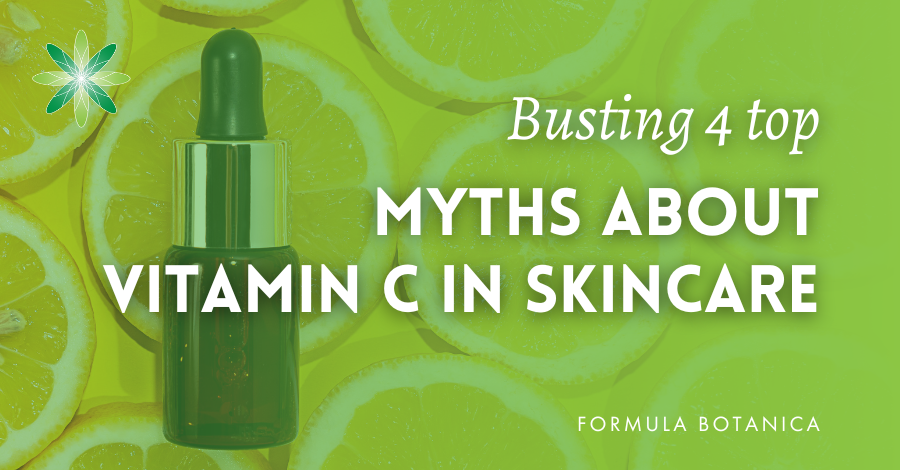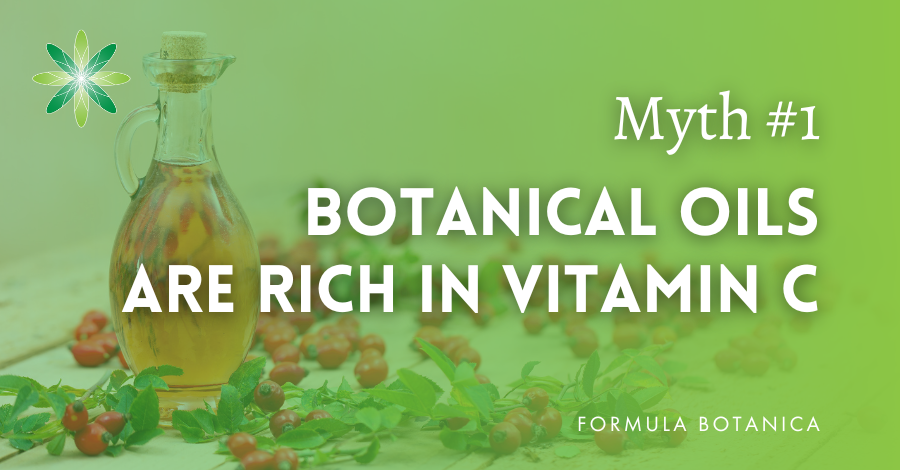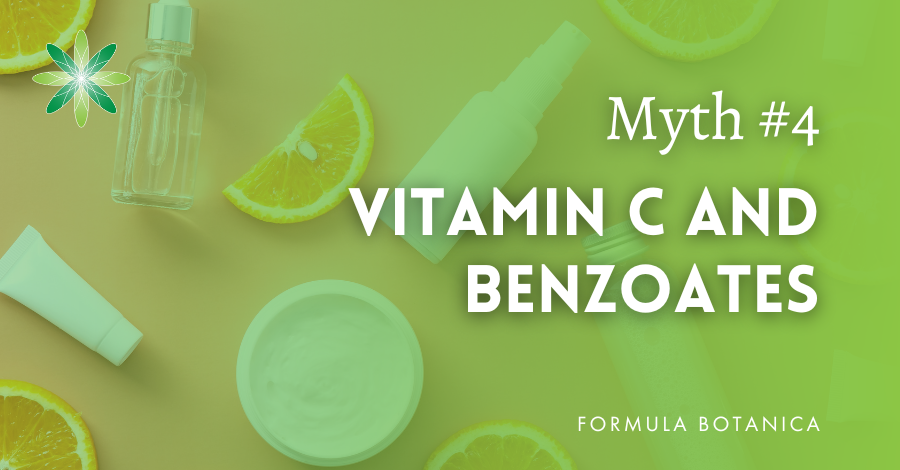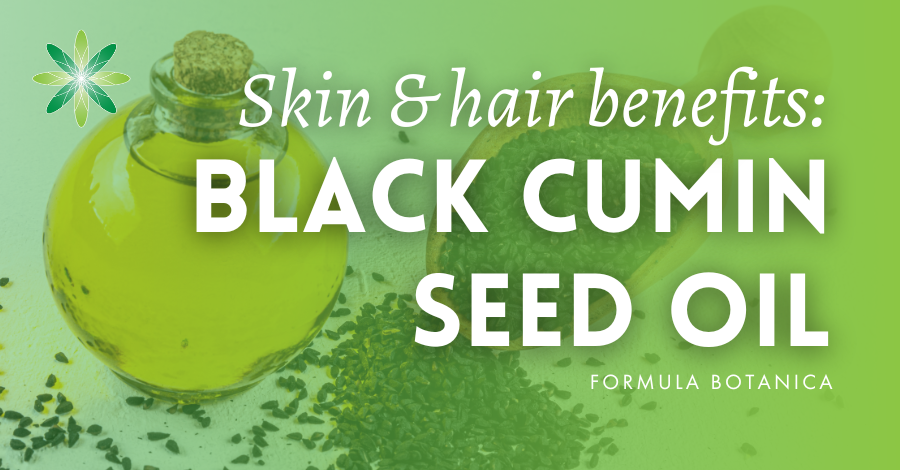In this post, we investigate some of the most common vitamin C skincare myths and see what makes sense – or not. Vitamin C is a well-known nutrient and a trending ingredient used in high-performance skincare, and for good reason. It is the most abundant antioxidant naturally present in our skin and the most well-researched vitamin for skincare use. But, as with everything that is so popular, there are various myths surrounding this active ingredient and its use.
Vitamin C properties
Vitamin C, or ascorbic acid, is an essential nutrient for human health. As we are not able to produce it, we need to obtain it from external sources – mainly food. It is also especially relevant for skin health. It protects the skin from oxidative stress and plays a role in collagen synthesis regulation, production, and stabilisation. In addition, it inhibits the activity of tyrosinase, the enzyme responsible for melanin production, helping to reduce dark spots and even out the skin tone. You can read more about its properties in our post:
Ascorbic acid
Vitamin C is found in nature as L-ascorbic acid and its salts, which is also the most biologically-active form of this ingredient. It is present in many fruits, such as Kakadu plum, camu camu, citrus and others, as well as in vegetables like broccoli and kale.
Ascorbic acid is a water-soluble compound that is very unstable and prone to oxidation. It requires advanced skills to formulate with this active ingredient in its pure form. However, there are also options for vitamin C derivatives that are more stable and easier to work with, but at some expense of efficacy. You can find out more about the pros and cons of various forms of water- and oil-soluble vitamin C derivatives in our post:
4 common vitamin C skincare myths
There are many specifics to note and details about how to use vitamin C in skincare and in which form. Sometimes, the overwhelming amount of information about these ingredients can be confusing, even for experienced formulators. No wonder misinformation has spread, as many natural formulators love this superstar ingredient and try to use it in as many ways as possible. Numerous formulation myths have arisen about vitamin C. In this post, we aim to shed some light on them and sort out the facts from the fiction.
You have probably come across at least one of these myths about formulating with vitamin C in skincare:
1. Rosehip oil and other vegetable and essential oils are rich in vitamin C
We have probably all read somewhere that rosehip oil is rich in vitamin C. And we can probably also admit to thinking at some point that our skin could benefit from the vitamin C properties found in oils such as orange essential oil. It is only natural to look for vitamin C in raw materials derived from fruits rich in it. Yet, this is one of the most common and widespread myths regarding vitamin C.
As we have already mentioned, ascorbic acid is a water-soluble compound. We tend to think that the oils of fruits rich in vitamin C will contain it too, but, unfortunately, this is not true. Although there are oil-soluble vitamin C derivatives, these are lab-processed ingredients that aren’t naturally present in fruits and vegetables. This means that ascorbic acid doesn’t have an affinity for oils and isn’t extracted along with them.
It is not uncommon to see suppliers or stores marketing the benefits of active compounds from the fruit itself instead of the oil, which is misleading and creates a lot of confusion. This is very often the case with rosehip, and many people buy its oil believing it will provide vitamin C properties.
The same goes for essential oils from citrus fruits and others. Although citrus fruits are known to be rich in vitamin C, their essential oils do not contain ascorbic acid, as it isn’t extracted through distillation or peel expression.
That does not mean rosehip or other oils don’t have wonderful actives and benefits. They do, but they are due to the presence of other active compounds and not vitamin C.
Bonus: what about vitamin C in other extracts?
Water-soluble extracts of fruits that contain vitamin C, such as oranges and camu camu, may contain ascorbic acid. Still, there are some points worth taking note of. The first is that, just as with the isolated compound, ascorbic acid present in fruits is unstable and can oxidise. So, the supplier of those extracts should guarantee that the product is processed in a way to stabilise ascorbic acid throughout the ingredient’s shelf life. Even if ascorbic acid stays unchanged, it would be present in low amounts in the final product, so its action would not be comparable to using purified ascorbic acid or other vitamin C derivatives.
As a side note: due to its polarity and solubility, ascorbic acid isn’t present in CO2 extracts.
2. Vitamin C causes sun sensitivity, so it should be applied at night
This is an interesting one. As you know, vitamin C acts mainly as an antioxidant. In contrast to other acids, ascorbic acid isn’t a chemical exfoliant and doesn’t cause sun sensitivity – quite the opposite. It helps protect the skin from free radicals produced from exposure to UV rays and reinforces the action of sunscreen (although it is not a sunscreen itself).
But, there is a reason why it is recommended to use some vitamin C serums at night.
Ascorbic acid is easily oxidised to dehydroascorbic acid (DHAA), a substance with a yellow to orange colour. A well-formulated product should protect your vitamin C from oxidation. If the product changes colour, it is a sign it is oxidising. This reaction is reversible, and through the action of other antioxidants, DHAA can be converted back to ascorbic acid. However, if the oxidation process continues and DHAA is decomposed, it can end up producing erythrulose, which is a self-tanning agent that can stain your skin to an orange/brownish tone.
This means that if you use a vitamin C serum made with ascorbic acid and apply it during the day, it can get oxidised by the action of UV light on your skin and stain it. If this happens, the colour will stay on your skin for some days until the dead skin cells shed. The staining can also appear if you are using a serum that has already oxidised.
So, the best way to avoid this undesirable look is to apply products at night that contain ascorbic acid. Wash your hands right after application, and remember to wash your face in the morning to remove the product. Products that contain other antioxidants such as vitamin E and ferulic acid may also help prevent the undesired staining. And, of course, it is always recommended to use sunscreen if you go out in the sun.
An important note – this recommendation is related to products containing vitamin C in the form of ascorbic acid. Formulations containing stabilised vitamin C derivatives won’t give rise to this type of problem, as these ingredients don’t oxidise as easily.
3. You can’t use vitamin C and niacinamide together
This is a widespread myth, that comprises a few variations. Some say you cannot apply different products containing vitamin C and niacinamide at the same time or that you can’t have them together in a formulation. The explanations vary, but some say that the acidic pH of ascorbic acid converts niacinamide into niacin (nicotinic acid) and that one cancels the effects of the other as they form a complex called niacinamide ascorbate. Let’s analyse these statements.
Breakdown of niacinamide to niacin
When niacinamide is mixed with acids, it breaks down to niacin. The concern here isn’t related to efficacy, but that niacin can cause your skin to flush and tingle, which is an unwanted reaction that can cause discomfort.
However, this reaction does not happen easily as niacinamide, like other amides, is a fairly stable compound, meaning it isn’t easily broken down. It would need to be exposed to extreme conditions for some time for this to happen, such as high temperatures and very low or very high pH. However, even at low pH, the reaction is more likely to happen in the presence of strong acids, although not so much with weak acids like ascorbic acid.
That said, it isn’t impossible that niacinamide could generate niacin in products with an acidic pH, like formulations with ascorbic acid, alpha-hydroxy acids, or others. However, it is very unlikely this reaction would happen to a significant extent during a product’s shelf life, which is why it shouldn’t cause any concern.
The same applies to using different products containing these actives; there simply isn’t enough time for this reaction to happen on your skin.
Niacinamide and ascorbic acid complex
Another possible reaction involves both actives combining their molecules to produce a complex called niacinamide ascorbate, which would supposedly cancel the effects of these ingredients. The amount of complex formed depends largely on the formulation’s pH, and its formation can be noted by a yellowish colour (different from that of an oxidised product, though).
Even in this complex, combined form, niacinamide and ascorbic acid are not strongly bonded to each other, and this reaction is reversible. It remains more stable at pH 3.8, and at lower or higher pH the molecules separate more easily. Although there aren’t many studies regarding the action of niacinamide ascorbate on the skin, it is more likely that niacinamide and ascorbic acid would separate again at physiological pH.
Niacinamide accelerates ascorbic acid degradation
Indeed, some studies have demonstrated that niacinamide can accelerate the degradation of ascorbic acid, but only under the action of UV light. So, if you wish to use both actives in the same formulation, make sure to use packaging with protection against UV light.
However, you might still be worried and keen to find out if there is another way to benefit from niacinamide and vitamin C together.
If you don’t feel confident formulating with niacinamide and ascorbic acid together, the easiest option is to use stabilised vitamin C derivatives instead of ascorbic acid. Apart from protecting ascorbic acid from oxidising and reacting with niacinamide, these ingredients can be used at a higher, near neutral pH, so you can formulate in conditions where these unwanted situations won’t happen.
4. Vitamin C will react with benzoates in formulation and produce benzene
This is a question we get from time to time from our students, as they are concerned that the reaction between ascorbic acid and benzoates can produce benzene, a carcinogenic compound. Benzoates are present in some essential oils in the form of benzyl benzoate and in preservative blends in the form of sodium benzoate, benzoic acid, or benzyl alcohol. These ingredients are often used to preserve botanical extracts.
The fear about this risk came from findings of the beverage industry, which detected benzene above the acceptable levels in some products containing ascorbic acid and benzoates. These products were reformulated by removing or reducing either ascorbic acid or benzoates and adding a chelating agent.
In cosmetics, this chemical reaction is possible but unlikely to happen to a significant extent for a few reasons. First, it would need a metal catalyst such as iron or copper in order to happen. Adding a chelating agent would help prevent the action of these metals. Also, the process seems to be favoured by exposure to light and heat. Still, we need to consider that ascorbic acid would probably be oxidised and change the formulation’s colour before it reacts to form benzene. So, there would be stability issues before the formation of harmful compounds.
In fact, we don’t have any actual data about this reaction happening in cosmetics, as research so far has focused on soft drinks. The latest Cosmetic Ingredient Review (CIR) safety assessment report on benzoates, from 2017, states the following:
“Data from model studies, pertaining to the beverage industry, reviewed by the Panel raised the possibility that benzene could be formed from benzoic acid and benzoates in cosmetics. The yields of benzene, however, that could be generated by photodegradation are sufficiently low that they do not constitute a relevant hazard.
(…) Accordingly, reference to present practices of use and concentration is sufficient to assure safety.”
If you are concerned, this is what you can do to prevent this reaction from happening:
- If possible, avoid the combination of ascorbic acid and benzoates.
- Use a chelating agent.
- Give preference to packaging with protection against UV light.
- Use stabilised vitamin C derivatives.
Conclusion on vitamin C skincare myths
We are well acquainted with vitamin C as a nutrient, and it has become a trending ingredient in cosmetics. So, it is only natural to look for this active in raw materials derived from fruits rich in vitamin C. People also want to understand the best ways to use it, benefit from its properties, and avoid any undesirable effects it may give rise to. However, it is not easy to find reliable content about this ingredient, and the internet is full of misinformation on vitamin C.
As you can see, myths usually have a reasonable background. But information spreads like a broken telephone game and ends up having its meaning changed by the time it reaches us. Rarely is all the knowledge we seek in one place, and it is not an easy job to gather the pieces of the puzzle together to make sense of them.
Sometimes, when people don’t find the answers they are looking for, they fill the gaps with whatever sounds logical. Of course, it is not easy to interpret scientific data or understand complex chemical reactions, which contributes to even more confusion. So, it is clear to see how these misconceptions about vitamin C came about. We still don’t have all the answers, and this is why cosmetic ingredient research is a continuous process.
If you’d like to find out more about vitamin C, and working with it as natural formulator, our exclusive members-only site The Lab at Formula Botanica dedicates an entire training module – or mini-lab – to vitamin C. Pre-register for the Lab when it next opens it doors for membership to gain access to the vitamin C as well as over 30 other specialist mini-labs for the natural formulator. The Lab gives you externally-accredited, continuing professional development (CPD).
Further reading
Ahmad, I et al., 2018. Photochemical interaction of ascorbic acid and nicotinamide in aqueous solution: A kinetic study.
Johnson, W et al., 2017. Safety Assessment of Benzyl Alcohol, Benzoic Acid and its Salts, and Benzyl Benzoate.
Nemet, I and Monnier VM, 2011. Vitamin C Degradation Products and Pathways in the Human Lens.
Guttman, DE and Brooke, D. 1963. Solution phase interaction of nicotinamide with ascorbic acid.
Finholt, P and Higuchi T, 1962. Rate Studies on the Hydrolysis of Niacinamide.
FREE TRAINING
Learn how to become an
Organic Skincare Formulator
FREE TRAINING
How to become an
Organic Skincare Entrepreneur
FREE TRAINING
How to become an
Organic Skincare Entrepreneur
Leave us a comment

Beatriz Amaral, a cosmetic scientist worked at Formula Botanica from 2021 – 2025. Read more about the Formula Botanica team.






























